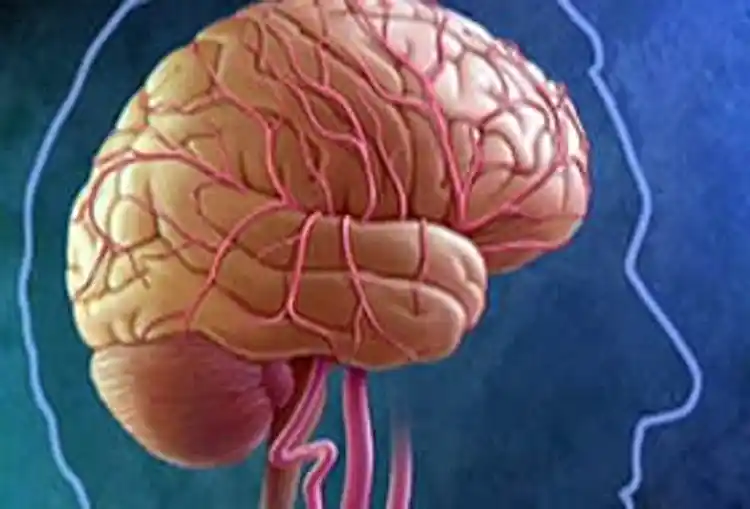July 17, 2023 – Alex McKeown, 33, works in a demanding and stressful job in the investment industry in Chicago, negotiating and closing deals for large retail companies.
“On the whole, I would characterize my health as pretty good,” he said. “I’ve never had major surgeries, I’m not overweight, I eat pretty decently, and I work out at the gym.”

But it was during a workout at his fitness center that everything changed.
“I woke up tired and probably wouldn’t have gone to the gym, except that I didn’t want to pay the $25 fee for a missed class,” he said.
After the first few minutes of his workout, he began to feel lightheaded.
“The room was heated and I was sweating, so I thought I was just dehydrated and needed to drink something,” he said. But soon he began to lose his balance and realized he needed to sit down on the floor.
The fitness instructor offered him water and orange juice. As he reached out to take the juice with his left hand, he saw that it was weak. He began sipping the juice, and one of the staff members noticed that he didn’t seem to be improving.
They called 911, and by the time the paramedics arrived, McKeown was losing control of his left arm and leg and couldn’t stand up on his own. He was taken to Northwestern Hospital, where he was diagnosed with a stroke.
Strokes in Young People
We tend to associate strokes with older people, but strokes can happen to anyone – although they’re much less common in younger people, according to Ali Shaibani, MD, chief of neurointerventional radiology and a professor of radiology at Northwestern Medicine in Chicago.
Shaibani, who treated McKeown, said it’s unclear what actually caused his stroke. Shaibani first suspected it was what is known as dissection, a tear in a layer of a blood vessel, but “that turned out not to be the case.” This type of injury is the most common cause of strokes in young people.
Some people also can have issues with their heart. McKeown was found to have a bicuspid aortic valve – a heart valve that has 2 leaflets instead of 3 – and an aortic aneurysm, a dilation or “bulge” in the aorta, the artery that sends oxygen-rich blood from the heart to the rest of the body.
Shaibani doesn’t know if these problems caused McKeown’s stroke. But he knew it was essential for the stroke to be treated as soon as possible.
“You lose about 1.9 million brain cells per minute with a stroke, so we moved very quickly to clear out a large blood clot that was blocking the artery leading to the right side of his brain,” he said.
McKeown was treated with TNK, a medication often used as a “clot buster,” and then put under anesthesia so that he could have a thrombectomy, a minimally invasive procedure that removed the blood clot, quickly restoring circulation.
The Role of Hypertension
High blood pressure is another common cause of strokes in younger people, according to a new study.
A team of investigators in Israel analyzed records of close to 2 million adolescents (ages 16 to 19 years) who were medically evaluated before beginning military service.
Over the years, there were 1,474 strokes, which occurred at a median age of 43 years old (with a range of 38-47 years).
Those with a history of adolescent high blood pressure had over twice the risk of having a stroke, compared to those without adolescent hypertension – even after accounting for other risk factors, such as BMI at adolescence and diabetes status throughout adulthood, said senior study author Gilad Twig, MD, PhD, of Sheba Medical Center in Israel.
He and his colleagues did the study because they felt the role of adolescent high blood pressure as a risk factor for strokes in the young is “under-researched,” although there’s an “increasing prevalence” of early strokes in many Western countries.
“The need for screening of hypertension among adolescents is unequivocal, and we believe that additional data regarding its consequences may support the belief that advocates the need for such screening,” Twig said.
His team recently published a study showing that being overweight or obese during adolescence may also increase the risk for strokes in younger adults, “suggesting the potential benefit of addressing risk factors already in adolescence.”
Other risk factors for strokes at a young age are similar to risk factors in older age, such as smoking and diabetes, according to Twig.
McKeown said he was never formally diagnosed with high blood pressure before his stroke, but he takes blood pressure medications now. And he may also have an issue with excessive blood clotting. He takes blood thinners for that, he said. He’s scheduled for a more extensive evaluation with a hematologist, a doctor who studies blood and blood disorders.
Don’t Dismiss the Signs
McKeown admits he would have likely dismissed his symptoms. “I would have told myself to just push through it, but I was surrounded by women at the gym – particularly the fitness instructor and another employee – and I’m so thankful they took my symptoms seriously and called 911,” he said. “Without them, I would have likely just tried to go home to sleep it off, and I probably wouldn’t be walking or talking right now.
No matter what your age, never ignore the symptoms. “If you’re ever in a situation where you’re questioning whether you need medical attention, call 911,” he said. “Even if it’s a 5% or 10% chance that it’s something serious, you need to bite the bullet and call. You’ll be much happier to be alive.”
Shaibani agreed. “Fifteen years ago, a lot of older people were ignoring signs and symptoms of stroke,” he said. “They weren’t aware that if you’re not using your arm or leg well, if you have slurred speech or a droopy mouth, that’s not something to ignore and hope it will go away if you take a nap.”
Younger people may not be clued in because strokes are less common in this age group. “In any age group, it’s not normal to have trouble using your arm or leg, have speech that sounds ‘funny,’ have a drooping mouth, or visual disturbances,” he said.
A good tool to help you remember stroke symptoms is BEFAST:
Balance: (a hard time walking, dizziness)Eyes (blurred vision, for example)Face (one side is drooping or it’s hard to smile)Arms (one arm is numb or hard to lift)Speech (speech seems slurred, hard to understand)Time (if any of these are present, it’s time to call 911)
“My recovery can be described as miraculous, owing to my getting to the hospital so quickly,” McKeown said. Time is of the essence in a stroke, and “I was getting surgery within maybe an hour and a half of the initial onset of my symptoms, which is pretty quick.”
He reports feeling “good, even later that day. I passed a swallow test that afternoon, I was speaking fine, and my strength was substantially back.” He was discharged from the hospital 6 days after his stroke.
Shaibani pointed out that many young people tend not to visit their doctors once they’ve “graduated” from seeing a pediatrician, so they may not be aware if they have conditions such as high blood pressure or high cholesterol. It’s important to find a primary care doctor and go to checkups regularly.
McKeown continues to have some “minimal residual symptoms,” such as recall issues with vocabulary words and some fine motor problems in one of his hands and legs, but he describes himself as “probably 98% or even 99%, pretty close to who I was before the stroke.” He’s not engaging in high-intensity exercise, but he does enjoy long, “leisurely” bike rides and keeps himself active. And he’s scheduled to have surgery to address his bicuspid valve and aneurysm.
>>> Read full article>>>
Copyright for syndicated content belongs to the linked Source : WebMD – https://www.webmd.com/stroke/news/20230717/what-young-people-should-know-about-stroke-risks?src=RSS_PUBLIC






























